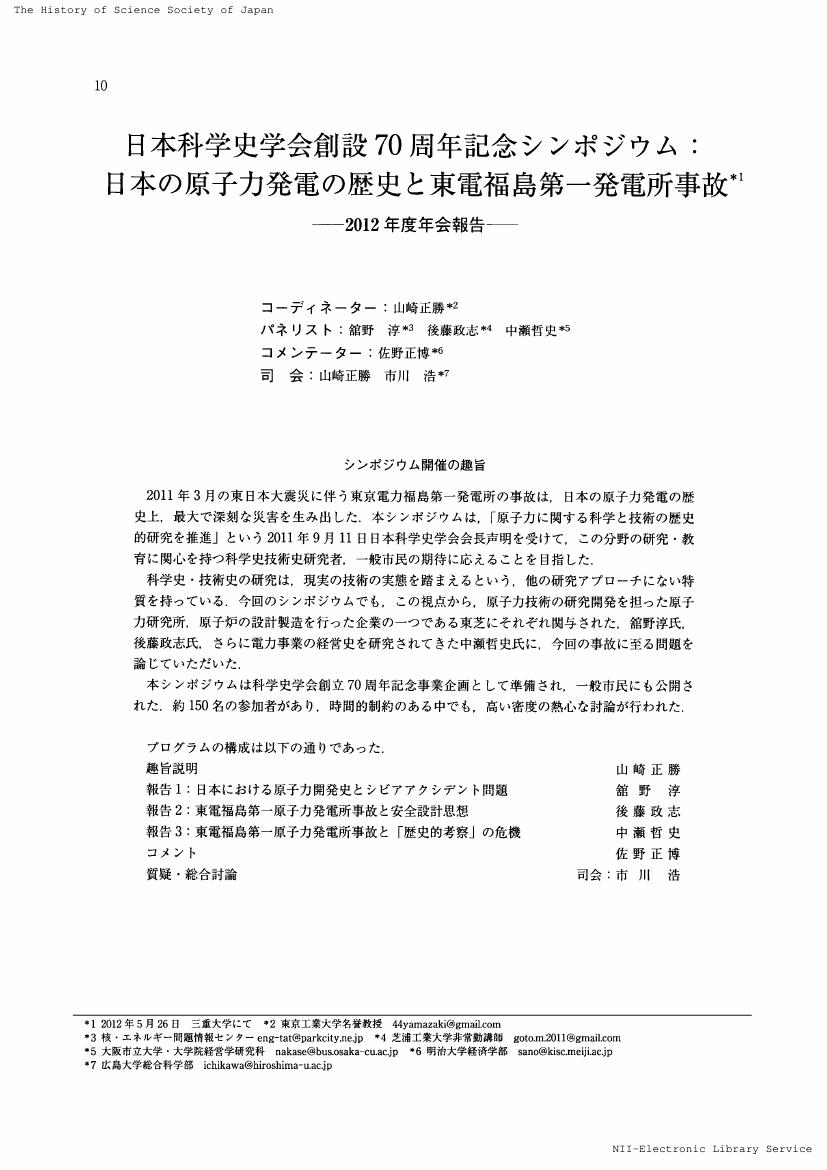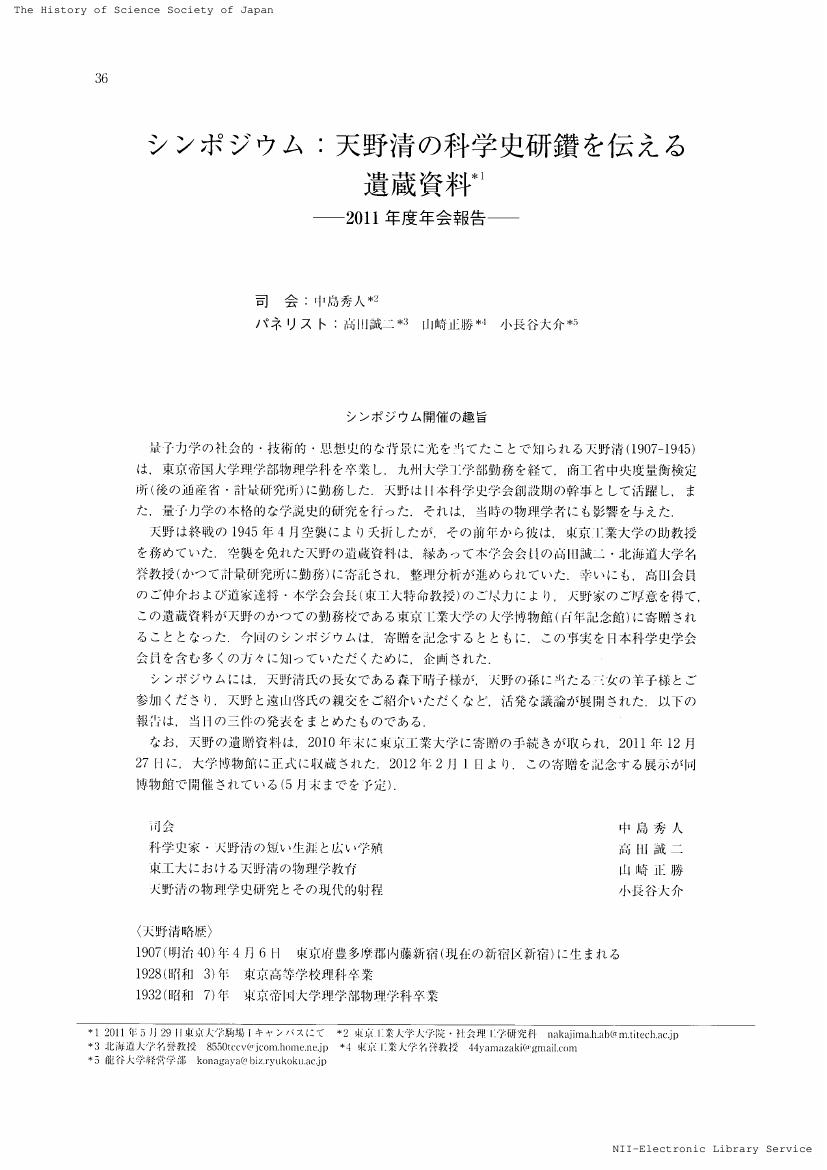52 0 0 0 OA 第二次世界大戦時の日本の原爆開発
- 著者
- 山崎 正勝
- 出版者
- 一般社団法人 日本物理学会
- 雑誌
- 日本物理学会誌 (ISSN:00290181)
- 巻号頁・発行日
- vol.56, no.8, pp.584-590, 2001-08-05 (Released:2008-04-14)
- 参考文献数
- 17
日本は第二次世界大戦期に核兵器を開発しようとした国の一つだったが,その正確な実態は,これまでほとんど知られてこなかった.計画に参加した物理学者たちの研究資料を分析することで,最近,彼らが行った研究の内容が次第に明らかになりつつある.ここでは,特に理化学研究所の人々が構想していた「ウラニウム爆弾」が,原子炉暴走型の爆弾構造であったことが示されている.
32 0 0 0 OA 平和問題と原子力:物理学者はどう向き合ってきたのか
- 著者
- 山崎 正勝
- 出版者
- 一般社団法人 日本物理学会
- 雑誌
- 日本物理学会誌 (ISSN:00290181)
- 巻号頁・発行日
- vol.71, no.12, pp.848-852, 2016-12-05 (Released:2017-10-31)
- 参考文献数
- 22
変わりゆく物理学研究の諸相 ―日本物理学会設立70年の機会に日本における物理学研究の転換点をふりかえる―平和問題と原子力:物理学者はどう向き合ってきたのか
19 0 0 0 第二次世界大戦下における各国の原爆開発過程の実証的な比較研究
1.史料収集:米国立公文書館等より市販されている原爆開発関係資料については、基本的に入手を終えた。主なものは、MED、ハリソン-バンディ、トップ・シークレット各ファイル、AEC関係資料、スチムリン日記などである。またブッシュ・コナント・ファイルの一部は、ゼロックス複写を得た。シカゴ治金研究所、ロスアラモス研究所関係の技術報告書の写しについても、重要資料については入手した。企業関係のものは、入手上の制約のため、デュポン社関係の一部を入手したに止まった。米国以外のものは、上記資料に含まれているものの他に、英国、日本における技術資料の一部を入手した。2.史料分析:爆弾構想の起源とその成立条件は、U、Pu爆弾についてほぼ全面的に明らかにされた。また、これと政策決定との相関についても明確となった。研究開発方式の選択・決定における軍の介入と科学者側との齟齬の問題については、その一部が明らかにされた。研究開発の諸側面については、軍事的要請が技術的変型を生んだ点がとくに注目され、平時では現実しない技術体系が、ウラン電磁分離法、プルトニウム分離における沈澱法、大型ウラン爆弾、大型インプロージョン装置などの採用と開発として、実現化したことが示された。投下目標については、政策決定者レベルでは、43年末まではドイツと日本が並列的に設定され、44年に、ドイツでの原爆開発が未完であることの察知と前後して、対日投下に一元化されたことが明らかにされた。また、投下の事前予測は相当正確になされたものの、その目的が実験と実戦使用における味方人員の安全確保におかれたため、不完全に終ったことが示された。科学者の動員、対応については、科学者がいくつかの階層構造を持つ点から分析が行われた。
6 0 0 0 第二次世界大戦期における原爆開発製造過程の実証的研究
(資料収集)今回、新たに入手した文書としては、米国ではロスアラモス研究所関係、英国ではO.フリッシュ、R.パイエルスの第二メモ、仏国ではジョリオ・キュリ-関係のものが代表的なものである。このうち後二者は、本研究でわが国では初めて入手されたもので、原爆問題をそれぞれの国の科学者たちがどのように考えていたかを知るうえで重要な文書である。また、日本の資料にもついても、GHQ関連の文書を入手した。(資料分析)(1)上記資料の入手により、シラ-ドら米国科学者と、仏、英の科学者の原爆に体する対応の共通性と相違点が明らかにされた。(2)シカゴ大学治金研究所の成立過程については、従来不明な点が多かったが、原資料の分析を通じて幾つかの重要な側面、例えば、同研究所が軍事研究所であったにもかかわらず、大学附置となったことによって、それまでの大学内の自治的な研究慣行が維持された、などが明らかにされた。(3)ロスアラモス研究所での原爆の研究開発過程についても、技術的開発過程を追うことによって、ウラン爆弾とプルトニウム爆弾の開発の競合の基本的過程が明らかになった。その中でとくに重要な点は、初期の砲撃型プルトニウム爆弾、スインマンの開発の挫折とその放棄で(44年夏)、これによって対独使用が技術的に不可能となり、対日投下が決定的となったことが示された。
5 0 0 0 OA ビキニ被災情報の国際的伝達と各国の原子力開発への影響
1954年3月の米国のビキニ水爆実験によって、第五福竜丸の乗組員が放射線被害を被った。その実態は、自らも調査に関わった当時大阪市立医科大学助教授だった西脇安によって各国に伝えられた。本研究では、遺族から提供された資料などの分析で、次のことが明らかにされた。(1)1954年の西脇の欧州訪問は、大阪の原水爆禁止運動が財政的に支えたこと。(2)訪欧中のジョセフ・ロートブラットとの出会いが、1955年の「ラッセル・アインシュタイン宣言」の重要なきっかけを与えたこと。(3)1957年のソ連及び東欧訪問でその影響が広がったこと。(4)1959年の訪米によってライナス・ポーリングの反核運動を支えたこと。
3 0 0 0 OA 原子爆弾と戦争廃絶・放棄論1945~1946
- 著者
- 山崎 正勝
- 出版者
- 日本科学史学会
- 雑誌
- 科学史研究 (ISSN:21887535)
- 巻号頁・発行日
- vol.58, no.290, pp.162-177, 2019 (Released:2021-01-24)
The "Russell-Einstein Manifesto" issued in 1955, a year after the Bikini incident, called upon the world for the abolition of nuclear weapons and war. It is well known that a similar assertion was made in a journal article in 1946 by Yoshio Nishina, one of Japanʼs prominent nuclear physicists who officially studied the damage of the atomic bombings of Hiroshima and Nagasaki. This paper shows that there were a wide range of arguments in Japan for the abolition and/or renunciation of war in the immediate aftermath of the atomic bombings. Naruhiko Higashikuni, the first Prime Minister after Japanʼs surrender, suggested the idea of "Peaceful Country Japan [Heiwa kokka Nippon]." Tanzan Ishibashi, an influential journalist and future Prime Minister in the 1950s, witnessed a drastic change in international relations caused by the atomic bomb, calling for Japan to become a "warrior for world peace [Sekai heiwa no senshi]." Kanji Ishihara, a former Army lieutenant general and military philosopher, understood that the emergence of atomic bombs and the pursuit of world peace under the United Nations after World War II as a sign of "world political unity [seijiteki sekai toitsu]" that he had anticipated prior to the war. Realizing that the atomic bomb had changed the way of war, Kijuro Shidehara, Prime Minister after Higashikuni, spoke to Supreme Commander of the Allied Forces Douglas MacArthur of the necessity of abolishing and renouncing war. MacArthur incorporated this idea into his demands concerning Japanʼs constitutional revision. All these individuals foresaw the meaning of Article 9 of the Japanese Constitution in the context of the nuclear age, hoping that Japan would be a pioneer of war abolition and renouncement.
3 0 0 0 OA 初期ガリレオにおける の法則と加速運動
- 著者
- 山崎 正勝
- 出版者
- 日本科学史学会
- 雑誌
- 科学史研究 (ISSN:21887535)
- 巻号頁・発行日
- vol.29, no.175, pp.167-171, 1990 (Released:2021-08-30)
In his letter to Guidobardo Del Monte in 1602, Galileo Galilei claims that he derives the law of conjugate chords, Prop. 36 in Two New Sciences III. M. Yoshinaka, W. L. Wisan and S. Ito suggest that Galileo obtains the law of conjugate chords from the mean proportional theorem just like in Two New Sciences. In this paper it is shown that the law of conjugate chords can be derived from the theorem of De Motu. The historical significance of the laws of chords and conjugate chords is discussed and it is maintained that these laws are the link that joined old Aristotelian to new Newtonian dynamics.
- 著者
- 山崎 正勝
- 出版者
- 科学基礎論学会
- 雑誌
- 科学基礎論研究 (ISSN:00227668)
- 巻号頁・発行日
- vol.30, no.1, pp.1-7, 2002-12-25 (Released:2009-07-23)
- 参考文献数
- 4
2 0 0 0 OA 小特集:安全保障技術研究推進制度を考えるフォーラム
2 0 0 0 OA GHQ史料から たサイクロトロン破壊
- 著者
- 山崎 正勝
- 出版者
- 日本科学史学会
- 雑誌
- 科学史研究 (ISSN:21887535)
- 巻号頁・発行日
- vol.34, no.193, pp.24-26, 1995 (Released:2021-08-27)
2 0 0 0 第二次世界大戦時の日本の原爆開発
- 著者
- 山崎 正勝
- 出版者
- 一般社団法人日本物理学会
- 雑誌
- 日本物理學會誌 (ISSN:00290181)
- 巻号頁・発行日
- vol.56, no.8, pp.584-590, 2001-08-05
- 参考文献数
- 19
日本は第二次世界大戦期に核兵器を開発しようとした国の一つだったが,その正確な実態は,これまでほとんど知られてこなかった.計画に参加した物理学者たちの研究資料を分析することで,最近,彼らが行った研究の内容が次第に明らかになりつつある.ここでは,特に理化学研究所の人々が構想していた「ウラニウム爆弾」が,原子炉暴走型の爆弾構造であったことが示されている.
- 著者
- 山崎 正勝
- 出版者
- 日本科学史学会
- 雑誌
- 科学史研究. [第III期] (ISSN:21887535)
- 巻号頁・発行日
- vol.53, no.270, pp.199-210, 2014-07-24
Japan and the United States signed in 1968 a new atomic energy agreement through which US light-water nuclear reactors, including those of the Fukushima Daiichi Nuclear Power Plant of Tokyo Electric Power Company, were to be introduced into Japan. This paper studies the history of negotiations for the 1968 agreement using documents declassified in the 1990s in the US and Japan. After the success of the Chinese nuclear test in October 1964, the United States became seriously concerned about nuclear armament of other countries in Asia including Japan. Expecting that Japan would not have its own nuclear weapons, the US offered to help the country to demonstrate its superiority in some fields of science including peaceful nuclear energy to counter the psychological effect of the Chinese nuclear armament. Driven by his own political agenda, the newly appointed Prime Minister Eisaku Sato responded to the US expectation favorably. When he met in January 1965 with President Johnson, Sato made it clear that Japan would not pursue nuclear weapons. Although the US continued its support after this visit, it nevertheless gave priority to the control of nuclear technology in Japan through the bilateral peaceful nuclear agreement. This paper argues that the 1968 agreement implicitly meant a strategic measure to prevent Japan from going nuclear and also a tactic to persuade Japan to join the Nuclear Non -Proliferation Treaty.
2 0 0 0 戦後日本における科学技術政策の史的研究
戦後の日本科学技術政策は、科学技術庁や科学技術会議などの機関があるものの一貫した整合性ある政策が形成され、もしくは施行されてきたとはいえない。通産省や文部省、あるいは農水省などの各省庁から出されてくる諸政策の集合体が、様々な科学・技術の発展過程に関与してきたにすぎない。当然ながら、それらの省庁間の諸政策には摩擦があり、ある意味での「力」の論理が現実を左右してきた。こうした政策のうち技術にもっとも密接に関与してきたのは通産省であったことは言うまでもない。通産省の技術関連政策は、技術導入や日本企業の国際的競争力の強化において極めて強力で企業を強く保護するものであったことは大方の指摘してきたことではある。集積回路やコンピュータを始め、電子工業に関する技術発展の重要な局面にはこの保護政策が強く作用した。この通産政策はしかし、国際市場における日本製品の競争力強化という点においては有効ではあったものの、技術を原理的に転換したり、あるいは人間社会の基盤的技術としての方向性を独自に作り出す方向には、有効に働いてはこなかった。この政策は、競争力強化という面においてさへ、コンピュータに新技術開発においても有効に作用しないばかりか、ハイビジョン・テレビのように根本的発展を無視した方向に機能し、むしろ問題になってきている。また、先の「もんじゅ」高速増殖炉事故の際問題となった「町工場」(下請け)と先端企業(本社)とを結ぶ社会的技術分業体制の転換・崩壊に見られるような生産体系の社会的構造の変化に対応する形で問題を把握することすら行い得ない現状を生んでいる。公害・環境問題に見られるように科学・技術の発展が社会的問題を惹起するように、しかも社会的弱者の土台の上に展開する構造すら見られる。人間社会が科学技術の発展に寄せる期待は、そのようなものではなかった。科学技術政策として重要な視点は、技術論的技術史的論理を踏まえた政策立案であるべきである。
2 0 0 0 戦後核関連科学技術政策に関する日米関係の実証的研究
この研究の発端となったのは,1994年放映のNHKの番組,「原発導入のシナリオ〜冷戦下の対日原子力戦略〜」である.原子力問題に関する柴田秀利(『戦後マスコミ回遊記』)の役割を,その番組ではじめて知ることができた.初年度は,アイゼンハワー図書館の資料を調査整理することに費やされた.同図書館で得られた重要な資料は,国家安全保障会議の原子力関係文書である.翌年,国立公文書館で国務省関係の資料を収集した.これらの資料から,アメリカ政府はビキニ事件の直後から,日本への原子力の平和利用計画を積極的に展開しようとしていたことを理解することができた.目的は,ビキニ事件で日本国内の反米,原水爆禁止活動を相殺することだった.柴田秀利の活動は,このアメリカの戦略に助けられたのではないかというのが,その時の感想だった.第3年度には,柴田秀利氏が残した文書の調査を行った,日米の資料をつき合わせることで,柴田秀利の活動の背後に,アメリカ政府の対日政策が存在していた事実をあらためて実証的に確認できた.また,柴田の『戦後マスコミ回遊記』で,柴田とアメリカとの橋渡しをしたとされているダニエル・スタンレー・ワトソン氏が,当時,国連軍の指揮官の任務に就いていたジョン・ハルの部下であった事実も明らかにできた.この関連で,柴田秀利氏の手紙から,氏の「毒をもって毒を制する」(原子力{平和利用}という毒によって日本国内の原水爆禁止運動と反米感情という毒を牽制するという意味)発言の時期が,1954年12月末であったことがほぼ確定できた.
- 著者
- 山崎 正勝
- 出版者
- 日本科学史学会
- 雑誌
- 科学史研究 (ISSN:21887535)
- 巻号頁・発行日
- vol.60, no.297, pp.1-18, 2020 (Released:2021-10-06)
Hidehiko Tamaki, who engaged the uranium criticality calculations at the Riken during the Second World War, died on February 10, 2013, and the related materials at Tamakiʼs house were preserved at the Riken Archives in Wako City, Saitama Prefecture. The author takes up a handwritten manuscript by Tamaki that begins with "§1. Necessity of chain reaction and factors that hinder its realization," and examines it using reproduction calculation. It is shown that Tamaki had obtained the mixture ratio of uranium and water as moderator so that it let the amount of uranium used minimum. It was also pointed out that there was a discrepancy in the formula of the output energy evaluated under the condition of constant pressure. After presenting a method to avoid it, Rikenʼs reactor system was reexamined, and it is shown that there was a lack of the concept of controlling chain reactions including consideration of delayed neutrons and neutron absorbers such as the control rods of todayʼs nuclear reactors, so it was difficult to use it for power.
1 0 0 0 OA 日本科学史学会創設70周年記念シンポジウム,2012年度年会報告
1 0 0 0 OA シンポジウム:天野清の科学史研鑽を伝える遺蔵資料,2011年度年会報告
1 0 0 0 OA 日本における「平和のための原子(アトムズ・フォー・ピース)」政策の展開
- 著者
- 山崎 正勝
- 出版者
- 日本科学史学会
- 雑誌
- 科学史研究 (ISSN:21887535)
- 巻号頁・発行日
- vol.48, no.249, pp.11-21, 2009 (Released:2021-08-04)
In the early years of the Cold War, both the United States and the Soviet Union used their nuclear power technology as a diplomatic tool for expanding their political influence on respective friendly nations. On December 8, 1953, the United States initiated a new international nuclear program with President Dwight D. Eisenhower's "Atoms for Peace Address" before the General Assembly of the United Nations. This program regarded Japan as one of the most promising countries that could introduce nuclear power plants since it consumed a huge amount of energy while being short of natural resources. This paper studies the historical process of the atomic energy agreement between Japan and the US in 1955 using declassified documents in both countries. It shows that in spite of various proposals of the introduction of nuclear power plants into Japan including that of Congressman Sydney Yates, the final agreement was only for research reactors because American authorities felt that such proposals might mean an admission of US guilt in atomic bombing. It also argues that the agreement was one of steps toward the hegemony of bureaucrats and politicians in Japanese nuclear policy that made the leadership of scientists, especially those of the Science Council of Japan, decline.
1 0 0 0 OA 技術の内的発展法則論と歴史の法則性(アゴラ)
- 著者
- 山崎 正勝
- 出版者
- 日本科学史学会
- 雑誌
- 科学史研究 (ISSN:21887535)
- 巻号頁・発行日
- vol.45, no.238, pp.103-104, 2006 (Released:2021-08-11)
1 0 0 0 OA ビキニ事件後の原子炉導入論の台頭
- 著者
- 山崎 正勝 奥田 謙造
- 出版者
- 日本科学史学会
- 雑誌
- 科学史研究 (ISSN:21887535)
- 巻号頁・発行日
- vol.43, no.230, pp.83-93, 2004 (Released:2021-08-12)
- 被引用文献数
- 1
In March 1954 a Japanese fishing vessel, Daigo Fukuryu Mam (Lucky Dragon No.5), suffered from radiation exposure from an American nuclear test at Bikini in the South Pacific. After this incident there appeared both in the US and in Japan a nuclear policy debate that the nuclear energy for peaceful purposes in general, and nuclear reactors in particular should be introduced into Japan in order to counter the communists' propaganda against American nuclear tests and anti-American movements in Japan. The Operation Coordinate Board of the US National Security Council adopted this policy very soon after the Bikini Incident. This was followed a wide range of strategic programs for Japan. Hidetoshi Shibata, then an executive of the Nippon Television Network Corporation, started his press campaign in January 1955 in the newspaper Yomiuri Shimbun together with its owner Matsutaro Shoriki, later the first president of the Japanese Atomic Energy Commission, for promoting nuclear energy for peaceful purposes. Shibata and Shoriki apparently were working together to fight against anti-nuke movements and anti-American activities in Japan. In May they invited John J. Hopkins, President of General Dynamics Corporation, Nobel laureate Ernest Lawrence from the University of California at Berkley, and Lawrence Hafstad, director of the division of reactor development of the American Atomic Energy Commission. Their talks in Tokyo were reported to have impressed many Japanese. This paper shows that Yomiuri Shimbun group's activities were in fact supported by the US government, and were carried out within the framework of the US foreign policy.





